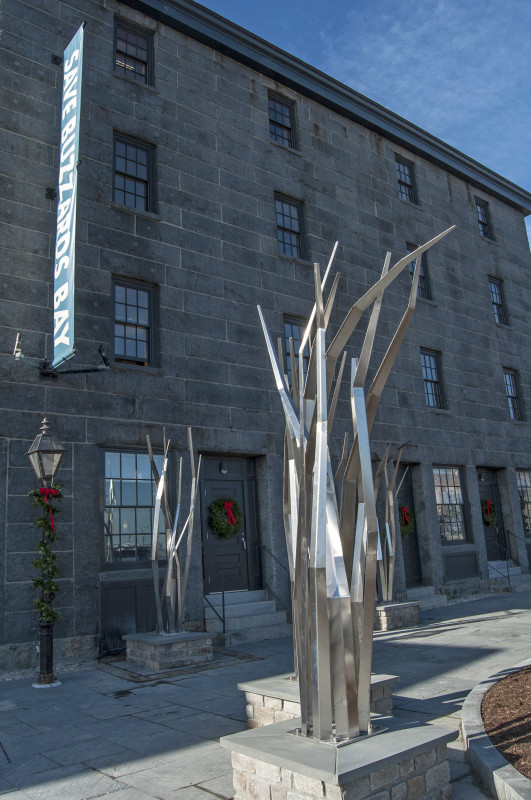Coalition unveils ‘Habitat,’ a site-specific art installation by John Magnan
As the sun set on a cold fall day, an outdoor public art installation came to life as the Buzzards Bay Coalition unveiled Habitat, a celebration of clean water in the heart of downtown New Bedford. Designed by local artist John Magnan and sponsored by the Coalition, Habitat is composed of seven steel and masonry representations of eelgrass, standing 12 feet tall and creating the illusion of an underwater meadow.

On November 30, the Coalition unveiled “Habitat,” an outdoor public art installation that celebrates clean water.
Eelgrass is essential to life above and below Buzzards Bay. Like a forest or a wetland, eelgrass provides habitat for many animals, including fish, crabs, birds, and bay scallops. But Buzzards Bay’s eelgrass is disappearing. The culprit is nitrogen, an invisible pollutant that seeps from homes, lawns, farms and roads into local waterways.
Habitat was unveiled today in a public ceremony in front the Buzzards Bay Center, the nonprofit organization’s headquarters and home to the Richard C. Wheeler Bay Learning Center. Coverings over the sculptures were lifted just as the lights that illuminate the installation were lit. A brief speaking program followed with remarks from artist John Magnan, Coalition President Mark Rasmussen and New Bedford Mayor Jon Mitchell.
“I’m honored to be given this opportunity to partner with the Coalition to create another art installation,” said Magnan. “What we have created highlights the importance of their mission while adding to the quality of life in New Bedford. Habitat is plainly visible to everyone driving Route 18 or using the new, welcoming pathways along Front Street.”
As the Habitat creator, Magnan designed the full-scale mockups and layout for the installation and coordinated the project, including supervising fabrication and installation. Many others lent their expertise, artisanry and support to its successful completion. The New Bedford Department of Public Infrastructure constructed the bases, Horacio’s Welding and Sheet Metal fabricated the steel sculptures, and studio2sustain provided structural design assistance. Others from City Hall, the City Council, and the Historical Commission were instrumental in securing approval for Habitat.
“We are heartened that so many people have supported this exciting installation,” said Rasmussen. “Everyone involved is volunteered their efforts, or offered them at cost without profit. We thank them for making Habitat possible.”
Habitat was constructed in a public plaza at the corner of Hamilton and Front streets created by the redesign of Route 18. The seven sculptures are spread around the plaza, creating a welcoming public space for residents and visitors to walk, gather and rest.
For residents and tourists alike who visit the plaza, Habitat will also serve as reminder of the beautiful, yet vulnerable underwater world just beyond our doorstep. Its creator, John Magnan, also hopes it will serve to inspire residents to work together to solve our common problems.
“This is an all-New Bedford project,” added Magnan. “It’s being created under the sponsorship of the Coalition, which is headquartered in New Bedford, designed and led by a New Bedford artist, built by New Bedford artisans and city staff, and supported by a New Bedford architect. We offer it as a gift that is truly of, by, and for the people of New Bedford.”